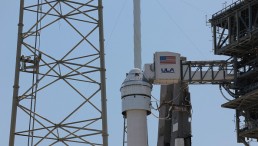!['Cosmic Glitch' in Einstein's Theory of General Relativity Could Be Explained in This New Scientific Tweak [Study] 'Cosmic Glitch' in Einstein's Theory of General Relativity Could Be Explained in This New Scientific Tweak [Study]](https://1721181113.rsc.cdn77.org/data/images/full/53435/cosmic-glitch-in-einsteins-theory-of-general-relativity-could-be-explained-in-this-new-scientific-tweak-study.jpeg?w=820)
(Photo : Wikimedia Commons/Gallery of Space Time Travel)
Albert Einstein's theory of general relativity has been proven true. However, there are instances when it is inconsistent, and scientists may have found a reason to explain this.
'Cosmic Glitch' in Albert Einstein's Theory of General Relativity
According to Einstein's theory of general relativity, gravity affects not only the four dimensions of time but also the three dimensions of space. This theory explains how gravity acts throughout the universe.
The theory suggests that space-time, a flexible fabric, represents the cosmos. This fabric bends with the mass of any object, including planets, stars, and even people.
The more mass an object has, the more it distorts its surrounding environment. Imagine placing a heavy ball on a rubber sheet that has been stretched -- the sheet will dip around the ball.
General relativity views gravity as the result of mass-induced space-time bending rather than as a force operating at a distance, as Newton did. Instead of being directly drawn toward one another by an unseen force, objects move toward one another by following the space-time curves that their masses have made. For instance, Earth orbits the sun because it is moving along the curved space-time around the solar rather than being drawn directly by it.
Observations and experiments subsequently verified the predictions of general relativity. For example, it predicted the creation of black holes, the bending of light by gravity (known as gravitational lensing), and gravitational waves-ripples in space-time caused by intense astronomical phenomena.
However, there are aspects that the theory can't sufficiently explain. According to Robin Wen, this gravity model is crucial for understanding everything from black hole photography to Big Bang theory. However, there seem to be contradictions between the predictions of general relativity and gravity when they attempt to comprehend it at the cosmic scale, which is at the scale of galaxy clusters and beyond.
It appears as though gravity itself ceases to precisely conform to Einstein's theory. This discrepancy, which they called "cosmic glitch," occurs when dealing with distances measured in billions of light years, at which point gravity becomes around 1% weaker.
Scientists have now come up with a new tweak that could possibly explain the inconsistencies that have baffled them for years. According to Niayesh Afshordi, a professor of astrophysics at the University of Waterloo and researcher at the Perimeter Institute, the expanding universe may have played a role in this "cosmic glitch."
"The farther away galaxies are, the faster they are moving, to the point that they seem to be moving at nearly the speed of light, the maximum allowed by Einstein's theory. Our finding suggests that, on those very scales, Einstein's theory may also be insufficient," Afshordi said.
i
ALSO READ: Is the Universe Infinite? Big Bang Theory Says Its Expanding, Speeding Up
What Is the General Theory of Relativity?
Einstein published the theory in 1915 to understand how gravity affects the fabric of space-time. It is an expansion of the theory of special relativity, which was published a decade earlier.
Although special relativity does not incorporate gravity, it maintains that space and time are intimately linked. According to this theory, Einstein demonstrated that the speed of light in a vacuum remains constant regardless of the observer's velocity and that the laws of physics apply to all non-accelerating observers.
Einstein discovered that big objects distorted space-time and included this information in the general theory of relativity. Envision positioning a huge item in the middle of a trampoline. The fabric would dimple when the object pressed down on it. The marble would then spiral inward toward the body if you tried to roll it around the trampoline's edge, similar to how a planet's gravity pulls at rocks in space.
RELATED ARTICLE: What's The Shape Of The Universe? Experts Say It Could Be A 3-D Donut!
Check out more news and information on Space in Science Times.










![Mars Faces Three Times More Potentially Hazardous Asteroids Than Earth [Study]](https://1721181113.rsc.cdn77.org/data/thumbs/full/53711/258/146/50/40/mars-faces-three-times-more-potentially-hazardous-asteroids-than-earth-study.jpeg)



